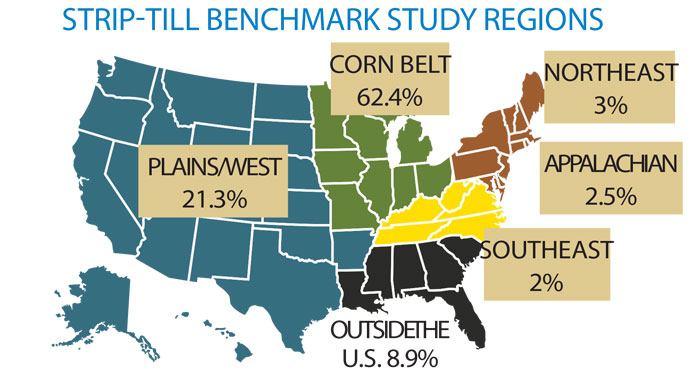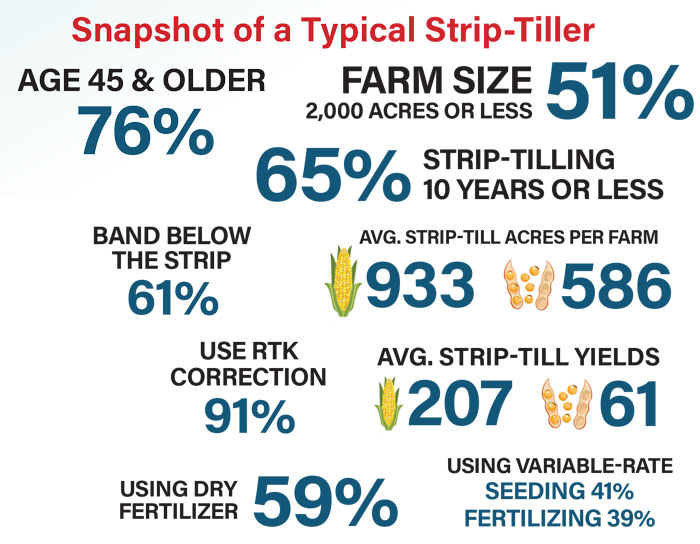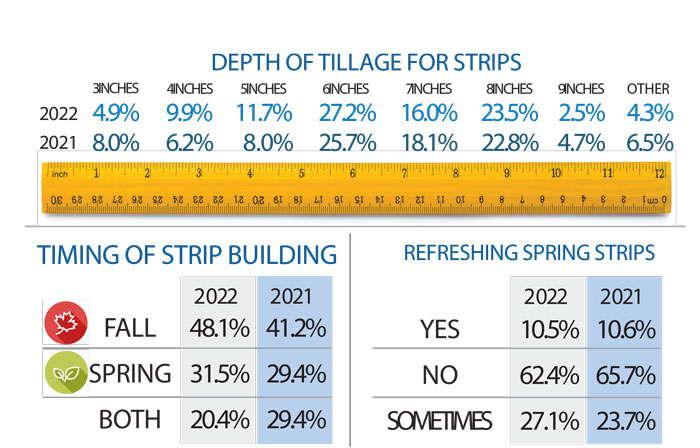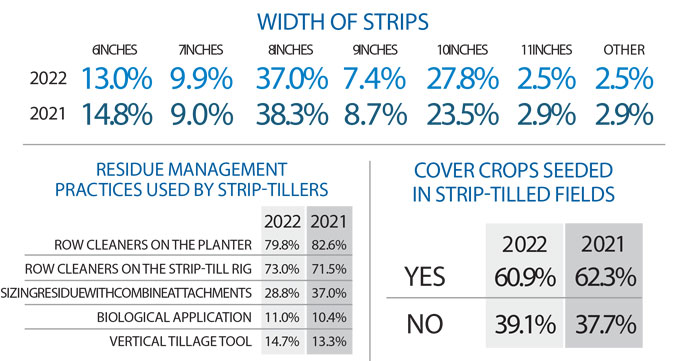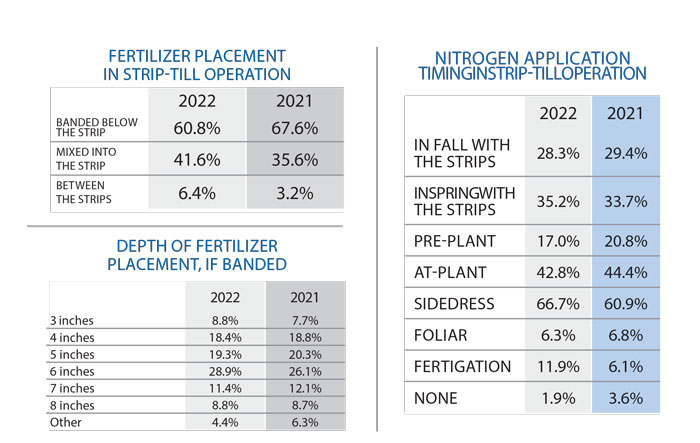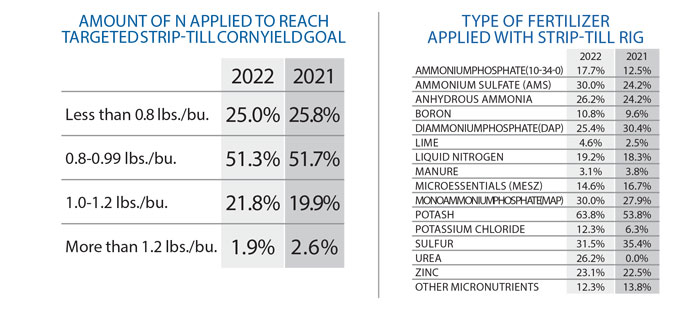Strip-Till Farmer’s 10th annual benchmark study of strip-till practices conducted in early 2023 shows that strip-tillers continue to have the upper hand over their no-till counterparts when it comes to corn and soybean yields.
Most of this year’s survey respondents farm in the U.S. About 62% operate in the Corn Belt, followed by 21% in the Plains/West. They farm an average of 1,751 total acres.
About 50% have been strip-tilling for 10 years or less, including about 15% who said 2022 was their first year strip-tilling. Total respondents strip-tilled an average of 933 acres of corn and 586 acres of soybeans — the highest total for soybeans and the second highest for corn (trailing only last year’s 1,083 acres) in the 10-year history of the survey.
Cover crops continue to be a popular conservation practice for strip-tillers. Almost 61% of respondents seeded cover crops in their strip-tilled fields in 2022, up nearly 8 percentage points from the inaugural survey conducted in 2014. Nearly 48% said they seeded multi-species cover crop mixes on an average of 529 acres. Cereal rye is the most popular species (65.8%), followed by radishes (32.5%), oats (30.7%), winter wheat (24.6%) and ryegrass (20.2%).
Yield Champions
The average soybean yield reported in 2022 by survey respondents was 61 bushels per acre on strip-till acres, the same as 2021. The average strip-tilled corn yield per acre was 207 bushels, up 5 bushels from 2021 and the second-highest yield in survey history. The highest average corn yield reported on the survey was 209 bushels in 2017.
Purdue University cropping systems professor Tony Vyn, who’s been studying strip-till since its earliest days, says there’s room for improvement, even though yield averages are in line with what he expected.
“I’m excited about those yield numbers — they’re solid, but they can go even higher,” Vyn says. “If you factor in the earlier planting opportunities that come with strip-tilled soybeans, there’s a chance to gain even more yield. And for corn, 207 bushels per acre is impressive but perhaps not enough.”
Both strip-till yield numbers are significantly higher than the 2022 averages reported by the USDA. The overall corn yield in the U.S. was estimated at 173.3 bushels per acre, while average soybean yields were 49.5 bushels.
Strip-tillers also yielded higher than their no-till counterparts in 2022. The 2022 No-Till Operational Benchmark Study reported average yields of 185 bushels per acre for corn and 54 bushels for soybeans.
These numbers mirror what Jason Webster sees at Precision Planting’s Precision Technology Institute (PTI) in Pontiac, Ill., where strip-till has proven to be more profitable than no-till, vertical-till and other systems at the 400-acre research farm.
“I’m excited about those yield numbers — they’re solid but they can go even higher…”
“We’ve been testing all of the major tillage programs, and strip-till has been our overall winner the last 5 years,” says Webster, who’s been managing the PTI Farm since 2018. “We teach our growers that with strip-till, you need to be flexible and have backup plans in case everything doesn’t go perfectly. Plan B entails freshening the strips in the spring. And then plan C is tear it up and start over.”
Spring or Fall?
48% of survey respondents build their strips in the fall, up nearly 7% from 2021, while almost 32% build strips in the spring. Some 20% build strips in both the fall and spring.
“I’m not surprised by those numbers because as you move toward sandier soils, it’s possible to get satisfactory results with spring strip-till, especially if you have a good systematic drainage system,” Vyn says. “My preference has been fall strip-till historically, but I’ve accepted spring strip-till if circumstances call for it or if it’s too wet in the fall.”
Carleton, Neb., strip-tiller Mike Schardt and Charles City, Iowa, strip-tiller Grant Stewart build their strips in the fall, while Rush City, Minn., strip-tiller Jon Stevens prefers the spring.
“Building strips in the fall allows me to apply fertilizer, break up compaction and prepare a great seed bed for the upcoming year,” Schardt says.
“I am trying some fall strips this year, but otherwise we’ve had great luck with strip-tilling in the spring,” Stevens says.
“It seems like strips built in the fall warm up faster in the spring,” Stewart says. “There is better water infiltration from rain and melting snow as well. We’ve had wet springs where we couldn’t plant on conventional or no-tilled grounds because it was too wet, but the strip-tilled ground was firm to drive on and dry enough to plant.”
The most common strip depth is 6 inches (27.2%), followed by 8 inches (23.5%) and 7 inches (16%). Eight inches (37%) is the most common width for strips, followed by 10 inches (27.8%) and 6 inches (13%).
Equipment
Strip-till toolbars with 12 rows were most popular among the 2023 survey respondents, with about 41% running a 12-row bar. About 33% run 16-row bars, and another 14% run 8-row toolbars.
The most popular brand of toolbar was Kuhn Krause (18.2%), followed by Case IH/DMI (16.4%) and Orthman (9.1%).
Curt Davis, Kuhn Krause marketing director, says the strip-till equipment market is becoming more crowded as major manufacturing companies invest in the practice.
“Strip-till has always been more of a side item for major manufacturers than what it’s becoming today,” Davis says. “There have always been a lot of manufacturers in the strip-till industry, but they’ve been the smaller, regional type companies. Now you see several of the major companies focusing more on strip-till. I think that’s being driven by demand from the customers.”
Other popular strip-till equipment included SoilWarrior (8.5%), Dawn Equipment (8.5%), John Deere (7.9%), Yetter (7.3%) and Unverferth/Blu-Jet (6.1%).


